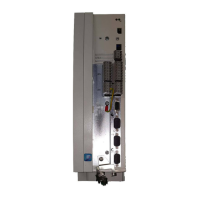Troubleshooting and fault elimination
Troubleshooting
3
L
EDKVF9333 EN 1.0
3.2 Error analysis w ith the history buffer
•
T he history buffer is used to trace faults.
•
Err or messages are stored in the order of their occurence.
Double-click the entry ”Diagnostics dialog” in the parameter menu of GDC to open the dialog box
Diagnosis 93xx
:
History buffer
3.2.1 Structure of the history buffer
•
T he history buffer provides 8 memory locations. The fields under ” Fault history” show the
memory loc ations 2 to 7.
•
T he fields under ” Actual fault” show memory unit 1. It contains information on the active fault.
– The first memory unit is written only after the elimination or acknowledgement of the active
fault. This entry eliminates the last fault from the history buffer so that it can no longer be
read.
•
T he history buffer holds three information units for every error that had occurred:
c F ault recognition and reaction
d T ime of the fault
e F requency of the fault
cde
T he following table shows the assignment of information and codes.
Code and information to b e retrieved Memory location
C0168 C0169 C0170 Subcode
Fault recognition and reaction Time of the last occurrence
Frequency of the immediately
following occurrence
1
Active fault
2
History buffer location 1
3
Memory location 2
4
Memory location 3
5
Memory location 4
6
History buffer location 5
7
History buffer location 6
8
Memory unit 7
CTi Automation - Phone: 800.894.0412 - Fax: 208.368.0415 - Web: www.ctiautomation.net - e.mail: info@ctiautomation.net

